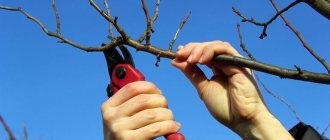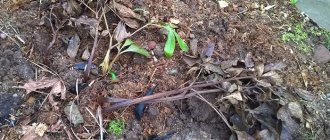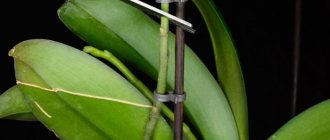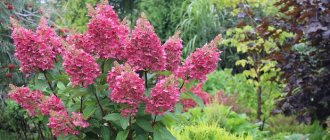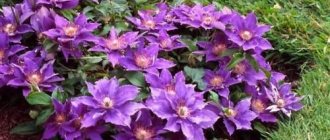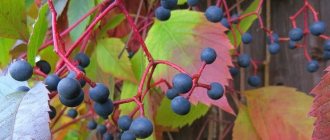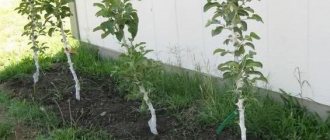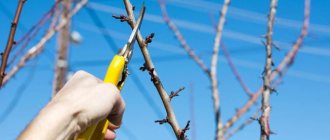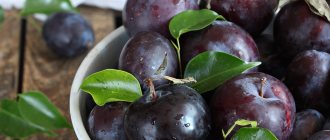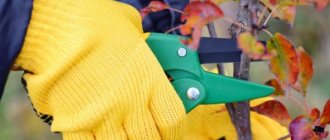The effect of pruning on the appearance and development of spirea
Spirea is the type of shrub that responds gratefully to pruning, even serious pruning. Such procedures stimulate both active plant growth and powerful flowering in all varieties, including spring-blooming and summer-blooming varieties.
Lack of regular pruning, on the contrary, will lead to the fact that the bush will look unkempt and turn into thickets with dry branches and weak, unattractive flowering - the bush simply will not have the strength to form new buds. Moreover, if you prune faded shoots in mid-summer (July), the shrub can bloom a second time as early as September! The main thing is not to forget to remove the wilted shoots again in the fall.
Thus, the main advantages of pruning are: a noticeable increase in the splendor of the bush, more abundant or even repeated flowering, giving the bush absolutely any shape, including the geometric shapes characteristic of a hedge. In addition, timely treated shrubs will allow more air and light to pass through. The procedure will minimize the risk of pest attack or diseases due to leaf decay deep in the crown. Spiraea is almost impossible to prune incorrectly , so do not be afraid to harm it with this procedure.
Let's talk about them in more detail
Spiraea "Grefsheim" (Spiraea cinerea grefsheim) is a hybrid of spirea sulfur. A perennial shrub with a fairly extensive crown, it blooms long and thickly. The branches are brown-red. The flowers can be white, pinkish or bright red in color, with a diameter of 1 cm. The inflorescences are located from the beginning to the end of the branch tightly to each other, have an umbrella shape and completely fall off after flowering. The bush grows up to 2 m.
Closer to autumn, the leaves acquire a yellow-golden hue, making the spirea look like a solar disk. It does not lose its decorative effect throughout the entire season, even in winter. The bare branches of the bush are so numerous that the plant does not look bald, but has a rather aesthetic appearance. Spiraea "Grefsheim" begins to exude the aroma in the second year of flowering, attracting many insects, especially bees, since it is a honey plant. If you don’t have enough pollinating workers at your dacha, then just plant spirea, it will attract the attention of all the bees to your plantings.
Gray spirea "Graciosa" (Spiraea arguta Graciosa) is a perennial with lush and long-lasting flowering. The height of the bush, as well as the diameter of the crown, reaches from 1.5 to 2 m. The flowers are umbrella-shaped, dense, snow-white. It blooms in May-June, abundantly covering the branches with small inflorescences up to 1 cm in diameter. The leaves are narrow, the branches are thin, falling like a waterfall, which gives the shrub more decorative.
Spirea "Arguta" (Spiraea arguta) has been known to plant growers since the 80s of the last century. People affectionately call it “May foam”. Flowers appear on last year's shoots and have very voluminous white garlands. The size of the inflorescence in diameter is from 0.5 to 0.8 cm, but there are so many flowers that they almost completely cover the leaves.
Tags: grefsheim, ashy, planting, spirea, care
About the author: admin4ik
« Previous entry
Technology for stimulating pruning of spirea in autumn
Young bushes need only minimal crown formation procedures. Autumn pruning should be carried out on a sufficiently mature plant , which is about 3-4 years old. This procedure is carried out half a month before the onset of the first frost - this time is enough for the cuttings to heal and for the plant to regain its previous strength for a successful wintering.
It is necessary to remove old and diseased branches using pruners - focus on the level of the root collar, as they will no longer bring any benefit to the plant. You should leave at least 5 buds on each stem. After such a procedure, the spirea will quickly recover, and in the spring it will grow young side shoots. By pruning the bush in this way, you can not only get rid of excess shoots, but also thin out the crown.
Before you start pruning in early fall, you need to make sure it will be appropriate. The fact is that spirea has many varieties: for example, if you have spirea Vangutta or gray spirea planted on your site, then you need to prune the bush immediately after flowering at the turn of spring and summer. Summer varieties, such as Japanese spirea, are best processed in the autumn. In addition, it is not recommended to carry out promotional pruning every year, as this will negatively affect the quality and abundance of inflorescences in the future. Weak and disease-affected shoots can and should be removed at any time of the year.
Planting a plant
Spirea Arguta - description, planting and care
Planting the Ashy Grefsheim spirea and caring for the hybrid is not difficult. Any method of reproduction inherent in it is completed successfully.
Note! Rooted cuttings are often used as planting material.
Planting from seeds
Spiraea gray Griffsheim does not reproduce by seeds. At least at home. The germination rate of hybrid seeds is only 4-5%. If you wish, you can verify this fact experimentally.
Planting seedlings in open ground
Seedlings can be planted in open ground in the warm season, preferably in spring.
When decorating a hedge, the distance between the bushes is left at least 0.5 m. For group plantings, the recommended distance is about 1 m.
The planting hole should be 2-3 times larger than the root ball. It is advisable to pour drainage (expanded clay, pebbles, broken brick) at the bottom of the hole.
Spiraea seedlings
How to rejuvenate autumn pruning of spirea
The lifespan of spirea greatly influences the procedures for processing branches: shrubs that are more than 7 years old must be subjected to fairly harsh root pruning. If you do not renew the bush in time, the old long shoots will begin to droop it towards the ground - this will adversely affect the decorative properties of the plant. To “rejuvenate” the bush, absolutely all shoots are cut down to the soil level (leave about 30 cm). You don’t have to worry about the shrub: with the onset of spring, the spirea will easily grow many young shoots in place of the old stems. Try not to leave “stumps” on which lateral shoots can grow - this will greatly deteriorate the decorative shape of the bush.
The best time for deep pruning is September or October. With proper rejuvenation treatment, the shrub will gain a second life: it will form a new crown without any signs of aging.
Important! If you are pursuing the goal of not only “rejuvenating” the bush, but also achieving the peak of its decorative properties, you should ruthlessly get rid of weak branches at all stages of the plant’s life cycle; To begin, after deep pruning, select the six strongest stems and work with them as a frame base. The process may take several years.
If even deep pruning does not help, and it is difficult for the bush to acquire young shoots, you should consider replacing or dividing the spirea into several parts. It must be remembered that the average lifespan of spirea bushes is 20 years.
A few more tips
You cannot ignore pruning if you want to get a beautiful, healthy and lush flowering shrub. In this case, you need to follow several rules:
- The first cutting should be done two years after planting.
- Each shoot of spirea develops up to four years, after which the process of dying begins. If you do not regularly trim the bush in a sanitary manner, it begins to dry out very quickly.
- Stems over seven years old are cut out completely.
- General sanitary pruning should be done in July, when it has completely faded.
- Radical pruning involves cutting off all branches to strong buds. Broken and dead stems are removed entirely.
- You cannot leave stems of the same age on a bush. Ideally, a few old and many new shoots should be preserved. Then the death of adult branches will not affect the appearance of the entire plant.
- It should be remembered that complete rejuvenation of a bush and pruning it to a stump does not always give the desired effect.
Love your plants and care for them properly. And they will thank you with their freshness and beauty.
Pruning spirea in the fall after transplantation
Spiraea tolerate autumn transplants very well. You can move the plant to a new location as soon as the first signs of a change in leaf color appear. On a cloudy day, replant the bush, and then carry out the necessary pruning, a kind of sanitization. The transplanted bush probably has accumulated many old, weak and diseased branches, which, when drying out, will provide a hospitable welcome to parasites and diseases. You need to get rid of skeletal shoots as soon as possible - they are cut back to a pronounced bud. After such treatment, you can support the spirea with fertilizers - this way the plant will be better prepared for the winter season.
Scheme and rules for autumn pruning of spirea hedges
Any variety of spirea can be used as a hedge, but such a green structure will require even more attention than ordinary bushes. The fact is that spirea grows unusually quickly, and therefore, once formed, a hedge without regular pruning will rapidly lose the clarity of its lines and look very sloppy.
Autumn hedge trimming is much preferable to spring trimming: this way you can gain some time for more important matters at the beginning of the summer season. The ideal time for this procedure is between September and October; Pruning of the “green wall” is carried out annually - this way the hedge will have the best density indicators.
It is customary to start cultivating a young hedge in the second year of its life cycle - during this period, the branches are pruned by a third of the total increase in length for the entire year. In older plants, branches can be cut to half the length of the total annual growth. If your hedge was planted quite a long time ago, then it is better to limit yourself to cutting only at the top, since old hedges are characterized by bare lower branches.
After trimming, a hedge, like any bush, will gratefully respond to fertilization, watering and mulch.
Diseases and pests
Grefsheim spirea is not susceptible to diseases, but the bushes have to be protected from pests. The culture is especially loved by juice-sucking insects such as:
- spider mite. It settles on a leaf and slowly draws juices out of it, depriving it of nutrition. The leaf blade turns yellow and falls off. At the first signs, the bush must be treated with chemicals. Phosfamide (0.2%) and karbofos (0.3%) are suitable. If necessary, treatment should be repeated after 3-4 days;
- bean aphid. This pest destroys inflorescences and tender young shoots. You can fight aphids with agrovertin, actara, and intovir;
- oxalum lancet. Gray butterfly. It is not dangerous to the plant, and its caterpillars can gnaw the entire bush. The same drugs used against aphids will help destroy the pest. For prevention, it is recommended to treat the bushes in early summer (before the buds open) and in the fall with one of the following drugs: fufanon, spark, fitoverm.
Sheltering spirea for the winter after pruning
Even fairly frost-resistant varieties of spirea need additional insulation during the winter season, especially in areas characterized by little snow or severe winters. The better the shelter is constructed, the greater the likelihood of successful wintering and abundant flowering next year.
You can eliminate the risk of freezing of the upper shoots by bending the spirea low to the ground and covering it with an impressive layer of leaves (15 cm), branches or vegetable tops. Newly planted plants should be covered in any case: they are still too weak to cope with frost alone.
Despite the fact that some varieties are able to withstand temperatures as low as -50°C, you should not take risks - winter in central Russia is not predictable.
Spreading spirea will perfectly complement any landscape design composition and become a bright decoration for your garden. The only thing you should never forget about is timely and high-quality pruning.
Use in landscape design
The plant can decorate any flower garden. To get a harmonious composition, you should choose additions in the form of crocuses, tulips, and daffodils. Bushes are also placed along a mesh or fence. After a few years they form a beautiful hedge.
The flower is actively used in landscape design
Spiraea bushes differ in flowering times. Many designers advise placing different varieties of this crop nearby. This helps in creating interesting compositions. Flowering bushes are combined with plants with small decorative berries.
Spiraea Grefsheim has excellent decorative properties. In order for the culture to develop well and bloom profusely, it is necessary to strictly follow the rules of care. It should be comprehensive and include timely watering, fertilizing, and pruning. Protection of crops from diseases and parasites is of no small importance.
